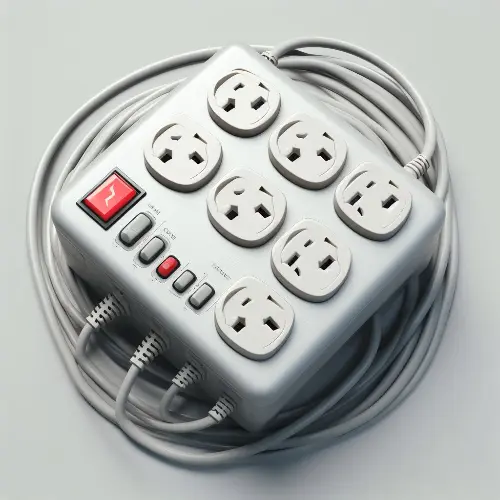Thekitchenkits.online is an Amazon Associate and earns from qualifying purchases made through affiliate links on our site at no extra cost to you. This supports our efforts to bring you valuable kitchen-related content.
Table of Contents
Can You Plug a Microwave into a Surge Protector?
Many people wonder if it is safe to plug a microwave into a surge protector or power strip. The answer is not quite as straightforward as you may think. While surge protectors are designed to protect your electronics from power surges, microwaves have specific power needs that may make surge protectors unsafe in some situations.
In this article, we’ll look at the key factors to consider when deciding whether to plug a microwave into a surge protector or power strip.
Should You Plug a Microwave into a Surge Protector?
The short answer is no, you should avoid plugging a microwave directly into a surge protector. Microwaves are high-wattage appliances that draw a lot of power, usually between 1000-1500 watts. Most surge protectors and power strips are not rated to handle that much power running through them continuously.
Exceeding the rated load can cause the surge protector to overheat, resulting in potential fire and electrocution hazards. This is why most manufacturers recommend against plugging high-draw appliances like microwaves into surge protectors.
However, there are a few exceptions where using a surge protector with a microwave may be okay:
- If you have a surge protector specifically rated for 15 amps or higher, it should be able to safely handle a microwave plugged into it. Look for a surge protector rated for at least 1875 watts or 15 amps.
- Only plug the microwave into the surge protector directly. Do not “daisy chain” surge protectors or use extension cords, which can easily overload a circuit.
- Avoid cheap low-quality surge protectors which may not be able to handle the microwave’s power needs. Opt for UL-certified surge protectors from reputable brands.
- Make sure there are no other high-draw appliances on the same surge protector that could overload the circuit when used together.
Key Things to Consider Before Plugging In a Microwave
Before deciding whether a surge protector is appropriate for your microwave, keep these important factors in mind:
Microwave Power Usage
Most standard microwaves use between 1000-1500 watts of power. This is considerable since most household circuits are rated for 15 amps or 1800 watts.
Check your microwave’s wattage rating on the back or inside the door to understand its power needs. The higher the watts, the more power being drawn.
Surge Protector Power Ratings
Many inexpensive power strips are only rated for 10 amps (1200 watts) or less. This is not enough for most microwaves.
Look for a surge protector rated for 15 amps (1875 watts) or higher to handle a microwave safely. Higher-end models may be rated for 20 amps or more.
Avoid Daisy Chaining
Never connect surge protectors together in a “daisy chain.” This can easily overload a circuit when multiple devices are plugged in.
Plug the microwave directly into the wall outlet or surge protector with no extension cords.
Microwave Electrical Needs
Microwaves require consistent, stable power to operate safely. Power surges and drops can disrupt the microwave.
Surge protectors help regulate power flow and protect the microwave from irregularities.
Other Appliances on the Circuit
Check what other high-wattage appliances like refrigerators, and space heaters are on the same circuit as the microwave.
Using them together could potentially overload the circuit and trip the breaker.
Fire & Electrical Risks
Exceeding the ratings of power strips and cheap surge protectors can overheat wires and pose fire & electrocution risks.
It’s safer to plug microwaves directly into the wall outlet whenever possible. Only use a surge protector if it is heavy-duty and properly rated.
Protecting Your Microwave from Power Surges
While plugging a microwave into a standard power strip is generally not recommended, you can still protect your microwave from power surges in other ways:
- Use a heavy-duty surge protector specifically rated over 15 amps for the entire house at the breaker box. This will protect all appliances on that circuit.
- Install a surge protector designed just for microwaves if you want targeted protection. These are equipped to handle high wattages safely.
- Unplug the microwave when not in use to avoid damage from power surges like lightning strikes.
- Plug the microwave directly into the wall outlet rather than an extension cord or lighter-duty power strip.
- Position the microwave away from sinks and other sources of moisture that can damage its electrical components during a surge.
FAQs
Can a microwave be plugged into a power strip?
It is generally not recommended to plug a microwave into a power strip. It is best to plug it directly into a wall outlet or use a dedicated surge protector.
Can a microwave be plugged into an extension cord?
It is not recommended to plug a microwave into an extension cord. Microwaves draw a significant amount of power and using an extension cord may not provide sufficient power, causing potential hazards.
Do I need to have enough outlets to use a surge protector?
No, surge protectors are designed to provide multiple outlets from a single electrical outlet. They are a convenient solution when you have limited outlets available.
Can I plug multiple appliances into a surge protector?
Yes, surge protectors are designed to handle multiple appliances. However, it is important to consider the total power load and ensure that you do not exceed the surge protector’s amp rating.
Should I never plug a microwave into a power strip?
While it is generally not recommended if you decide to plug a microwave into a power strip, make sure the power strip can handle the wattage and amperage requirements of the microwave.
What is a daisy chain and why should I avoid it?
A daisy chain is when you plug multiple power strips into one another. It is not recommended because it can overload the circuit and create a fire hazard.
Can plugging a microwave into a power strip trip the circuit breaker?
Yes, if the microwave draws too much power, it can trip the circuit breaker. It is recommended to check the power requirements of your microwave and ensure that the circuit can handle it.
Can a surge protector protect my microwave during a thunderstorm?
Surge protectors are designed to protect your electronics from voltage surges caused by power fluctuations. While they can help, it is best to unplug your microwave during a thunderstorm to avoid any potential damage.
Should I use a surge protector to protect my microwave?
Using a surge protector is a good way to protect your microwave from power surges. Make sure the surge protector is rated for the wattage and amperage of your microwave.
Conclusion
Plugging a high-wattage appliance like a microwave into a power strip or surge protector can be risky. However, with the right heavy-duty surge protector and proper precautions, some protection from power surges is possible.
The most important thing is checking the amperage ratings and only using a surge protector designed for the microwave’s power needs. For minimal risk, directly plugging into a properly wired wall outlet is ideal.
The main points are:
- Avoid plugging a microwave into a standard surge protector or power strip unless it is rated for 15 amps or higher.
- Microwaves require 1000-1500 watts of steady power that cheap power strips cannot provide safely.
- Only use a 15 amp+ rated surge protector. Never daisy chain or use extension cords.
- Check your microwave’s wattage rating and the surge protector’s specs first.
- Plugging directly into a wall outlet is the safest option to avoid overheating and fire hazards.
- You can add a whole house surge protector at the breaker box if you want to protect a microwave circuit.

I’m Ian Welkins, a seasoned professional in the kitchen industry. My passion now drives me to provide invaluable insights into the world of top-notch kitchen products. With years of hands-on experience, I’m your go-to source for culinary excellence.


